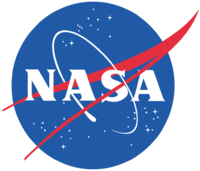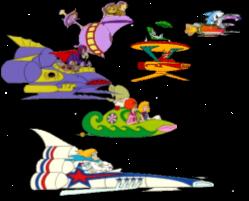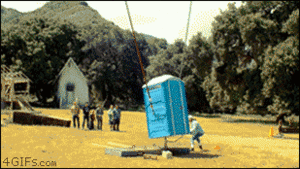NASA
The National Awesome Space Agency (NASA) is an entity of the United States government that is responsible for all things relating to space. This includes space travel, spacewalking, space aliens, and Kevin Spacey. Its most well-known accomplishments include landing on the moon and inventing a pen that can write in space. NASA currently has plans to return to the moon after a 45 year hiatus; critics say that this is a 'bad idea' and 'the moon was terrible to NASA, why should NASA take the moon back?' Other plans include colonizing Mars in case of slight incidents on the Earth, combating rogue asteroids, and reaching into space as deep as Uranus. and reaching into space as deep as Uranus.
The motto of NASA is "for the benefit of all", referring to its goal of eventually putting every person, place, and object on the Earth into perfect circular orbit. The administration is constantly under fire from angry taxpayers claiming that it is a waste of money; such detractors are known to vanish and reappear months later in the Nevada desert.
History
Originally formed in 1787 when America's founding fathers set aside a large portion of the nation's resources for a space program, NASA was put on hold for more nearly two hundred years. In the 1950s, the Evil Soviet Empire began work on their space program, eventually launching a number of inanimate objects into space. Endless taunts by USSR radar bases and furry hat factory workers caused the United States much shame due to their inability to retaliate in kind. When the Soviet "Muttnik" program successfully launched several stray dogs into space and returned them safely, America could stand losing no longer, and resurrected NASA in 1958.
The race
The competition between the Americans and the Soviets during the 1950s is often referred to as "the space race", with each country trying to outdo the other by launching increasingly large and/or delicate things. However, the US quickly fell behind, as the Soviets had a large head start. By the end of 1959 the Russians had successfully launched a large glass swan into orbit and returned it to Earth without breaking it, while NASA had only managed to manufacture a large number of magnificent explosions. Finally, in 1961, the Soviets achieved an 80% survival rate in their space-dog program, and greenlit the first human orbit of the Earth.
In April of 1961, Cosmonaut Yakov Smirnoff entered a large metal object. Seconds later, an enormously large explosion was set off underneath that object, and Smirnoff became the first Yakov to leave the Earth while still medically alive since Jesus. Tragically, after returning safely to Earth, Smirnoff was nearly killed in a reckless attempt to break the standing land-speed record of the time, which he made by employing an experimental Russian double reversal based on a prototype jet-powered unicycle ("In America, to feel speed you need cycle over land round round, like record spin by jet engine. In Soviet Russia, jet-speed record spin round round over land for feel dead need, so kill YOU!"). In the meantime, NASA continued to create larger and larger explosions, with minimal success. It was at this point that President John F. Kennedy delivered his famous speech, imploring America to "commit itself to achieving the goal, before this decade is out, or before I am assassinated (whichever comes last), of landing a man on the Moon and returning him safely to the Earth".
This rousing oratory gave NASA precisely the motivation it needed. Within weeks, the first successful orbit of the Earth by an American satellite was completed by Explorer I. Project Mercury was established, and Alan Shepard became the first American in space. Project Gemini established human beings' ability to survive long-term spaceflight durations. All this was completed very rapidly in the early 1960s by NASA control rooms full of pencil-necked nerds armed with pocket protectors and horn-rimmed glasses operating in time-and-a-half, manning banks of hundreds of lit-up buttons that had to be pressed in precisely the right order at precisely the right time (which produced precisely the right musical tones, influencing the popular electronic game "Simon", which recreates the intense stresses of being a NASA control operator). Finally, in 1966, America was ready to aim for the moon.
Apollo
Apollo was an ambitious plan by the United States to launch black musicians to the Moon. Its goal was to allow these musicians to perform on the lunar surface, and then return them safely to the Earth. The program was a huge success, with six lunar landings each more boring than the last.
President Kennedy's aforementioned speech challenged the nation's scientists, and indeed, the whole of America, to reach the moon with great entertainers such as Ella Fitzgerald and James Brown. His proposed goals were initially met with skepticism by leading scientists. Complaints included "but NASA can't afford a project of that scope" and "what can my country do for me?" Kennedy responded by allotting NASA a budget of approximately 94% of the total money that existed in America in 1966 (around fifty thousand dollars), and delivering a moving speech containing his most famous quote, "Ask not what your country can do for you; we're actually pretty busy here and you should realize that there's like two hundred million of you, so it might be a while before we can get around to doing anything for you. Seriously, get a job."
NASA scientists worked around the clock for eight years converting the famed Apollo Theater into a spacecraft that could withstand the harsh trek from the Earth to the Moon. Finally, with the last-minute additions of heat shields (to protect the musicians from the extreme temperatures of re-entry) and cool racing stripes (to protect the musicians from the barrage of cosmic rays, the solar wind, and the interplanetary medium in general), three black performers were ready to be launched to the moon in mid-1969.
On July 16, 1969, the three black crew members entered the Apollo Theater for what promised to be a "jive ride". The crew members were Commander/Trumpeter Louis Armstrong, Lunar Module Pilot/Pianist Stevie Wonder, and Command Module Pilot/Vocalist Marvin Gaye. With more than seven hundred million people watching, the theater lifted off from 125th Street in Harlem. Three days of intense sound checks later, the crew was making preparations to descend to the lunar surface. It was at this point that they realized that Wonder was, in fact, blind, and thus could not fly the lunar module. Cursing irritably under his breath, Gaye, who had been looking forward to a nap after 77 consecutive hours of driving, climbed into the lunar lander and joined Armstrong.
After touching down, it was determined that Armstrong would be the first on the Moon, after he guessed closest to the number that NASA director Ed Harris was thinking. Armstrong descended the ladder and set foot on the lunar surface as billions of people watched in mild amusement. Once standing ankle-deep in the delicious powdery moon dust known as regolith, Armstrong broke out his trumpet. The first song he played was one written specifically for the mission, titled "One Small Step For (a) Man". He then joined Gaye in a ninety-minute set, one that would echo through the ages as part of one of Mankind's greatest achievements.
After the successful launching of Louis Armstrong to the Moon, the Apollo Program launched many other black artists. The Apollo Theater made regular returns to the Moon over the next fifteen years. Musicians such as Luther Vandross, Ben E. King, and Diana Ross all had lukewarmly received shows in the 1970s. In early 1981, Michael Jackson spent a considerable amount of time on the lunar surface, perfecting the moonwalk that would make him famous. The Apollo Program was officially discontinued in 1983 due to lack of interest and money shortages. However, the program still holds its famous amateur nights, in hopes of discovering an up-and-coming black artist capable of re-sparking America's interest in space exploration.
The shuttles
In the early 1980s, NASA finalized plans for building a fleet of reusable "space shuttles" to be used for the colonization of space. These plans materialized during the height of America's worldwide imperialism movement; namely, 1981. With Americans running out of room, the vast expanses of space seemed like a perfect location to "dump our unwanted stuff, like nuclear waste and Mexicans". Alternatively, it was thought that outer space could readily be used to exile society's most heinous villains, similar to how Mediocre Britain had previously attempted to make a penal colony out of New South Wales, the Crown's continent-sized terrestrial colony "Down Under" (known today as the distinct continent and "independent" Commonwealth English "nation" of Australia), back in the 19th century before the sun set on the British Empire and rose over the American Empire. However, America's "space-prison" concept was abandoned after the Hollywood Box-Office success of several science fiction films depicting scenarios resulting in the conquest of Earth by apes with damned, dirty paws.
The first and primary function of these shuttles was to bring components of the International Space Station into orbit, where the station could thus be assembled. A second – and ultimately, less well-received – function of NASA’s space shuttle was to "wow" the American public (and intimidate foreign powers) by utilizing the shuttle’s innate ability to spontaneously combust into a gigantic ball of apocalyptic flame filled with searing metal wreckage and vaporized flight-crew rosters within mere seconds of lift-off. The shuttle program more than exceeded expectations concerning this second function; between 1986 and 2012, multiple NASA shuttles intermittently detonated shortly after launch in broad daylight, each time in a highly-visible manner at suborbital altitudes. Although only meant as a secondary function, the pyrotechnic aspect of the program made an indelible impression on people of all stripes worldwide and in the end became the most memorable feature of the shuttle program.
Unfortunately for NASA, the explosive nature of the shuttles emboldened conservative doomsayers, who began proclaiming that NASA's shuttle program and the aforementioned International Space Station were nothing but the crux of a covert, trans-national Axis of Evil Hot Dog Eating Competition, in which the shuttles and space station comprised nothing less than a dastardly superweapon of mass indigestion. NASA held fast against such critics and insisted at all times that the shuttle program was purely peaceful and scientific. Given that the truth of the matter lay somewhere in between, the shuttle program would manage to last several full decades before finally giving way to outside condemnation.
Time did indeed catch up with the program and its flaws, despite the best efforts of NASA to achieve an enduring victory. The event that ultimately triggered the demise of the shuttle was particularly dramatic. In what proved to be NASA's ninth formal "Space Shuttle Lightshow Spectacular", staged on December 23, 2012, at Cape Cod, Florida, and featuring the Space Shuttle Hiroshima, the aptly-named craft suddenly detonated while still on its launch pad – and then again twenty minutes later at an altitude of 7,000 feet. This proved to be a major bureaucratic annoyance in the short run; to the horror of millions of white men wearing pocket-protectors, NASA barely avoided minor budget cuts the following fiscal year in 2013.
Still, after the fateful "Hiroshima 'Whoopsie'", it became clear even to the most diehard shuttle proponents that the end of the Space Shuttle Era was at hand. Contrary to the old Irish adage that "nothing changes, New Year's Day", on January 1, 2013, all scheduled experiments involving the space shuttle (principally, weightlessness and combustibility studies) were immediately and indefinitely shelved. All undetonated space shuttles were fully decommissioned and retired from service by the end of 2013. Today, when not spontaneously bursting into flames, the retired space shuttles enjoy a quiet, pastoral existence in rural Florida consisting of daily shuffleboard tournaments and perrenially waiting for court-ordered visitiation sessions from their Generation Space X children (now under the sole legal custody Elon Musk) at their NASA Assisted Launch Care Facility in the great "Panhandle State".
Personnel and recruiting
The staff of NASA consists mostly of the pencil-necked nerds mentioned in the History section of this article. Since the 1960s, their pocket protectors and horn-rimmed glasses have given way to leak-proof pens and horn-rimmed contact lenses, respectively. NASA has had many directors, ranging from the down-to-earth Billy Bob Thornton to the chain-smoking alcoholic Ed Harris. Occasionally NASA will hire outside contractors, such as deep-core drillers, when a budget surplus necessitates blowing many things up in space.
NASA recruits astronauts from "space camps", where young children go to laugh and pretend they are astronauts. Those who pretend the hardest become astronauts. However, these camps are highly selective, and the only way for children to attend is to win a week at space camp on one of Nickelodeon's game show programs, many of which were hosted by former NASA director Mark Summers. These game shows test children's ability to handle astronaut-type stresses such as finding a red ribbon in a vat full of green slime, sliding down a ramp into a vat of green slime, and catching rubber chickens in a laundry basket.
The future

NASA has broad, sweeping plans for the future of space exploration. Their current conquest to return to the moon is already underway, with several illegal spy satellites already en route to lunar orbit. The agency has also set its sights on Mars, in an ingenious gambit that would completely cut off Jupiter's supply line to Venus. Although remotely controlled machines have touched down on the red planet, human presence is necessary for a "total conquest". NASA hopes to have several colonies on the Moon and Mars by 1990 2000 2010 2020 2037. These colonies will send tributes of rocks and dirt, and be taxed astronomically so as to discourage any space-rebellions.
Another one of NASA's top-secret projects involves research into highly controversial areas such as religion. With the advent of computers and supertechnology, it has been possible to "look for God" using highly sophisticated remote sensing equipment. Right-wing conservatives have demanded fair time on several of the agency's largest telescopes, and the current administration has ensured that they receive it. These groups have also lobbied for equal time using assets such as cancer research labs and puppy shelters for their own religious research, evicting the former inhabitants.
The success of these religion projects has been minimal. Modeling things such as the fluid dynamics of the Last Supper and the projectile physics of Jesus' ascent into Heaven have not been well received by the public. The future of these endeavours is unclear as several of the more controversial findings (such as His wife, speedboat, and children) have been kept quiet. If the program is discontinued, the religious right will have to go back to the old standard: making stuff up.
As far as the distant future, NASA has several ideas waiting for technology to advance to a sufficient level. For example, nuclear engines may make interstellar travel possible, and humans could be colonizing extrasolar planets within the next hundred years. Also, once genetic engineering catches up to aerospace engineering, sharks may replace human astronauts. These so-called "sharkstronauts" will have the advantage of a system of cartilage rather than bone, rendering them less susceptible to radiation and extreme acceleration. Also, sharkstronauts will be far better suited for an encounter with any kind of predatory space creature, such as a space-orca.
See also
- The Apollo Program
- Apollo Creed
- Moon hoax
- UnScripts:Who built the moon
- Project Orion
- AIDS (Space Program)






